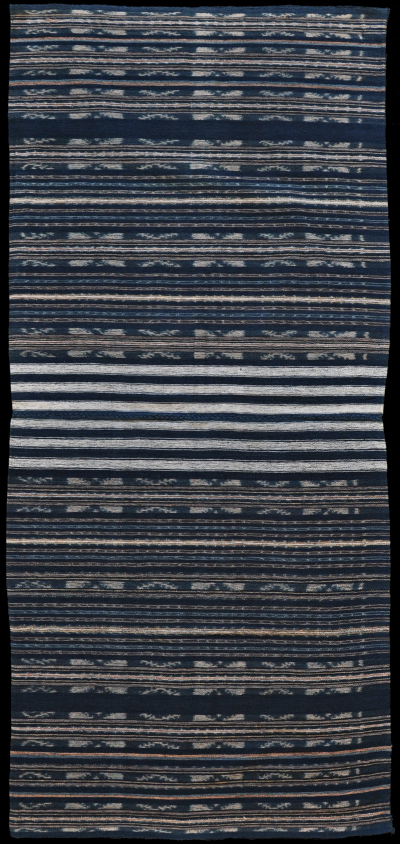| |
 
 | | | |
165 Moluccas, Tanimbar
Tais (sarong)  
| | Locale: | Yamdena, probably. | | Period: | Before1950. | | Yarn: | Cotton, hand-spun, medium | | Technique: | Warp ikat | | Panels: | 2 | | Size: | 60 x 131.5 cm (1' 11" x 4' 3") LW: 2.19 | | Weight: | 445 g (15.7 oz), 282 g/m2 (0.92 oz/ft2) | | Design: | Vintage marriage sarong of a type called tais marin in the language of Yamdema, identifiable as such by the characteristic six white bands in the midsection. In Fordata would be called bakan maran. Various bands and stripes with small motifs, the characteristic 'flags' and 'half moons'. The second ikat band from the top and the second from the bottom are flanked by red-blue stripes, the so-called 'rainbow stripes'. | | Comment: | The most popular type of Tanimbar sarong, produced on all the islands, suitable for all occasions up to smaller festivities. The white bands are arranged over the buttocks - so as to accentuate them during dancing - with the top part of the sarong folded down. This example has six white bands in the mid-section rather than the eleven that came into fashion in the second half of the 20th c. Vintage example with excellent weaving in pristine condition. Microscopy reveals, rather unexpectedly, that even the yellow pinstripes were done in hand spun thread. Ex Gisela Lautz collection. | | Background: | Chapters on Moluccas and Tanimbar. | | Exhibited: | Museu do Oriente, Lisbon, 2014/15 | | Published: |
Woven Languages, 2014.
Ikat Textiles of the Indonesian Archipelago, 2018.
| | Compare: | 079 080 173 | | Sources: | Similar to bakan maran in collection Thomas Murray, depicted in Taylor and Aragon, Beyond the Java Sea, Fig. VIII.34, though with less detailed drawing. Susan McKinnon, Flags and Half Moons, in Gittinger, To Speak with Cloth, Fig. 8, shows group of dancing Tanimbarese women, three of them wearing this type of sarong. Pattern shown in Van Vuuren, Ikat from Tanimbar, Fig. 47. Similar sarongs worn by sister and niece of village chief on Tanimbar, kampung Alusi Krawain, Yamdena island, on Tropenmuseum photo below, TMnr 10005683, dated ca. 1920.
 | | |

©Peter ten Hoopen, 2025
All rights reserved.
|
|


